To help, I’ve gathered 20 website content ideas to reignite your creativity. These are from my experience as a marketer, insights from the HubSpot team, and tips from top content marketing experts.
With each idea, I’ll share actionable tips so you can apply them on your own website.
20 Website Content Ideas [+Examples]
- Use your own problems as inspiration.
- Address a customer pain point that frequently comes up in sales calls.
- Find a trending topic with a timely news peg.
- Dispel myths about your products.
- Experiment with video.
- Repurpose existing content.
- Conduct original research.
- Compare your products against your competitors.
- Take readers behind the scenes of your business.
- Refresh existing content.
- Invite guest authors to publish on your website.
- Publish case studies (lots of them).
- Create content that challenges norms in your industry.
- Answer FAQs with dedicated pages or posts.
- Flesh out your social media content into blog posts.
- Create a comprehensive glossary.
- Offer predictions into the future of your industry.
- Build your business in public.
- Publish your income report.
- Create post-event content.
1. Use your own problems as inspiration.
Best for: When you want to connect with your customers and add value.
Real-life example: How Do You Communicate You Have Capacity Without Sounding Desperate? from Spring Insight Marketing
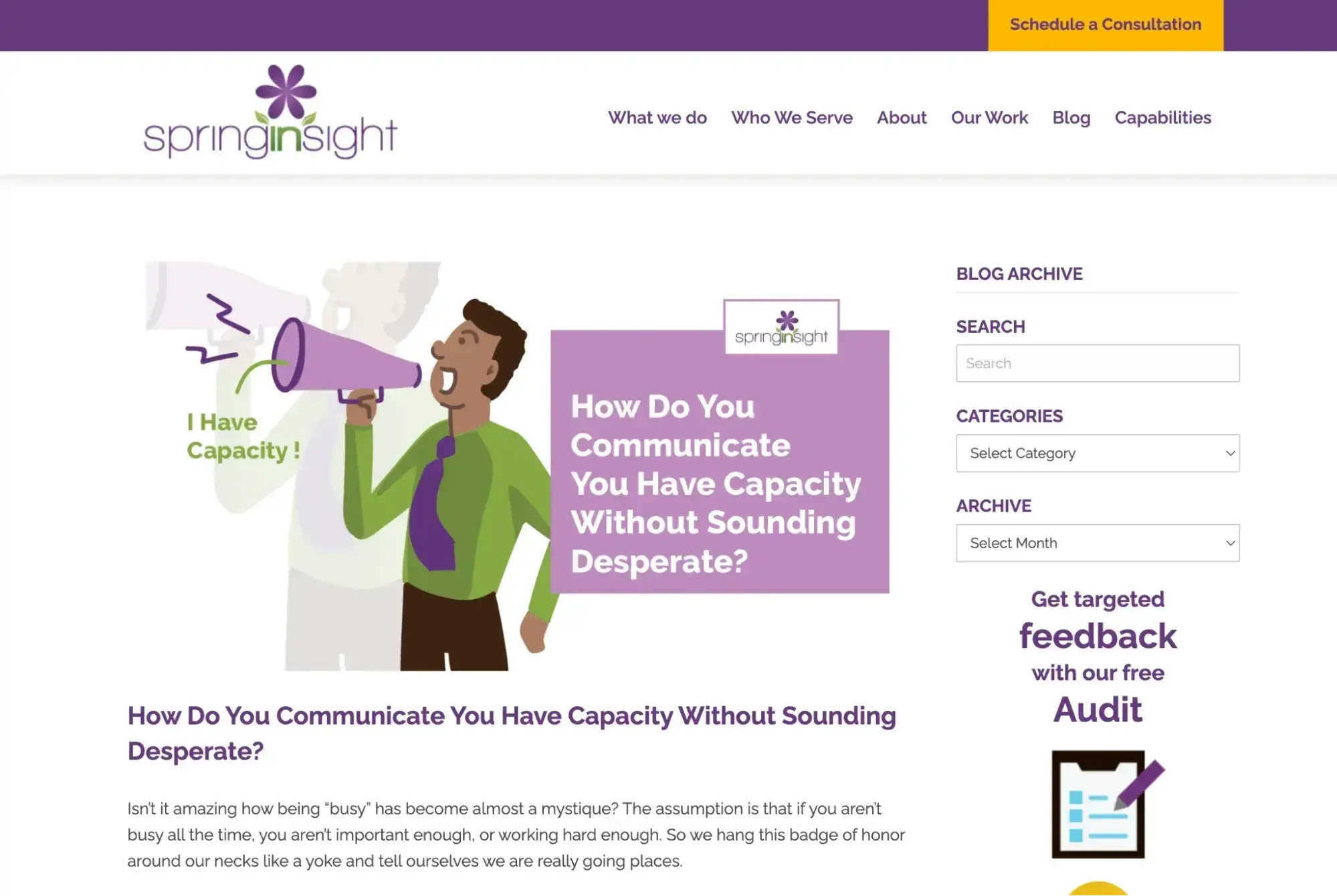
Spring Insight founder Erika Dickstein is in a position any marketer would envy. “There are a variety of problems in my business,” she tells me over Zoom. “But creating content and getting content ideas has never been one of them.”
I came across Erika’s work thanks to the following LinkedIn post she shared, which seemed to resonate with many business owners.
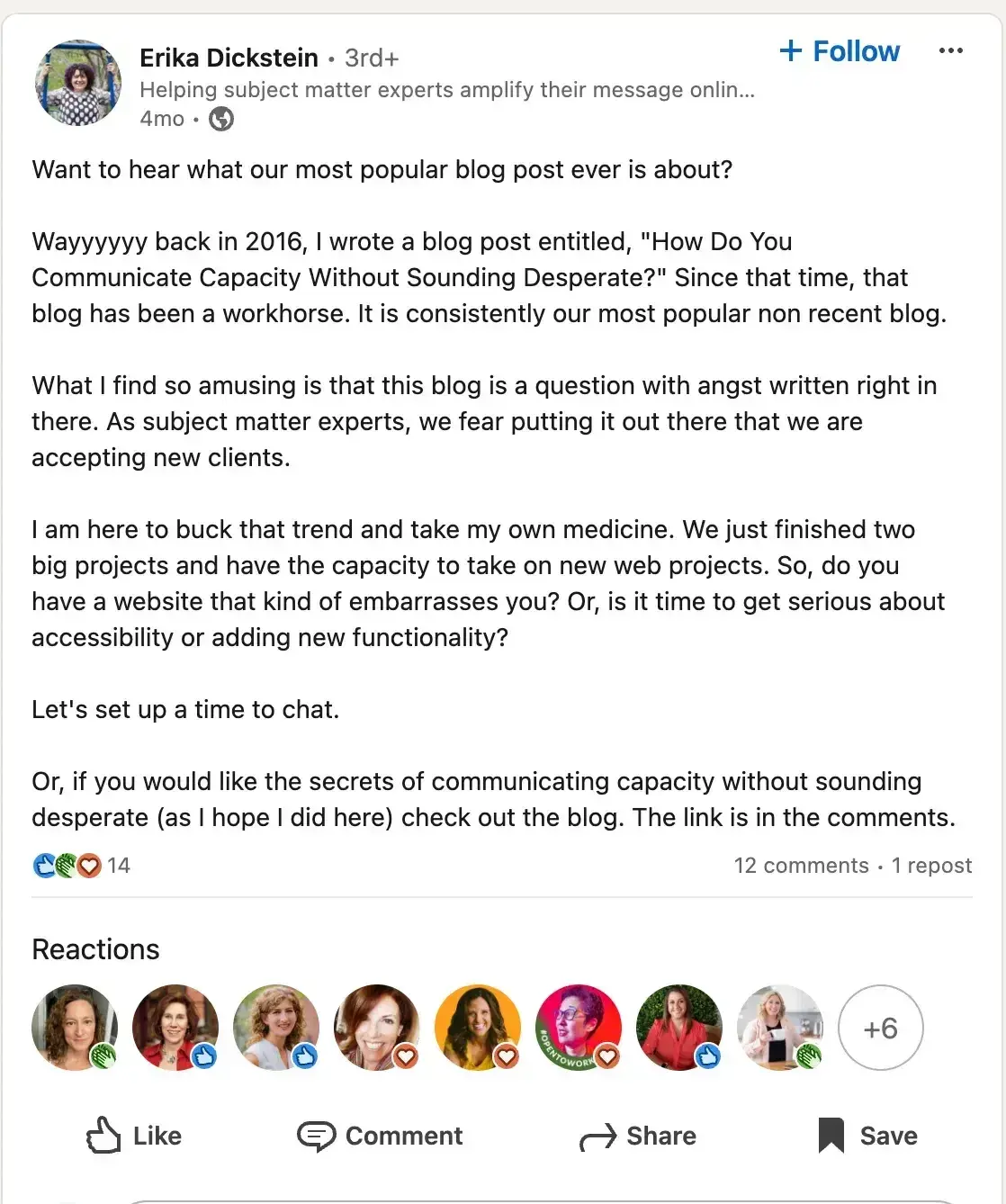
To date, her blog post “How Do You Communicate You Have Capacity Without Sounding Desperate?” remains one of her most popular — and she wrote it back in 2016.
So how did she create this website content that lasts? Well, when she wrote that post, it was because she had a problem finding new clients.
However, she also wanted to help others in her position by offering answers to her own question.
“I like to help people,” says Dickstein. “So this [blog post] is one that I think is along the lines of, ‘I like to help people’ as opposed to ‘this gets me a lot of work.’”
How to make it your own: “Always be listening,” advises Dickstein. The only way she could write a blog post that resonated with her audience was by understanding them deeply.
“Always be listening to what are the questions that people are asking you, and don't just be listening, but have a mechanism,” she says. Dickstein’s mechanism at her business is a Slack channel where team members can submit questions from customers or elsewhere.
Using automation, Dickstein directs these questions to an Airtable idea hub that Spring Insight can reference later for content generation.
If you’re not a pro at generating endless ideas, thankfully, the HubSpot Blog Ideas Generator can help.

For instance, let’s say I am struggling to generate blog post ideas for a golf niche site. All I have to do is enter a keyword like “women’s golf apparel” into the Blog Ideas Generator. And voila! It came up with a list of five website topic ideas, along with keywords.

So, as you’re listening to your customers’ questions, try typing any recurring words into the Blog Ideas Generator and see what content ideas spring from it.
2. Address a customer pain point that frequently comes up in sales calls.
Best for: Creating content that supports your sales team.
Real-life example: 5 Ways HR Can Get CFOs To Advocate For New Leave Software from Tilt

Tilt’s content strategist Gabe Prusak is a prolific writer on his company’s blog. So I was particularly interested in finding out where he gets his website content ideas.
His secret sauce? He and his marketing team listen to recordings of sales calls. “Not all of them, of course, because there's a lot,” Prusak explains, “but we watch them, and we pick up issues that [customers] seem to have.”
By doing this, Prusak and his team noticed a recurring theme: prospects wanted Tilt’s software — but their leadership team didn’t understand the value of it.
From there, Prusak and his team:
- Identified the C-suite members who would benefit most from their product and brainstormed strategies to win their support.
- Created a timeline, assigning each quarter of the year to focus on a specific stakeholder. For example, in Q1, they targeted the CFO, which led to the creation of the blog post mentioned earlier.
- Developed content to help their ideal customers present compelling information to get buy-in from decision-makers.
The resulting blog post outlining how HR teams can get buy-in from their CFO now has the highest engagement of any Tilt content this quarter.
How to make this your own: See if you can get recorded sales calls or interview your reps to uncover recurring themes they’re hearing from prospects.
Then, go one level deeper. “Focus on the problems that [your customers] maybe don’t realize that they’re having,” Prusak says.
He gives the example of leaves of absence, which Tilt software addresses. Customers may complain about inefficiency in their process, but the actual issue is that leaves of absence are inherently unpredictable, and they aren’t equipped to handle that.
“So focus on the root problem, because they might think it‘s one thing, but actually, it’s another,” he says. “And when you do it well, you‘ll know. How? The message will make your audience say, “Oh my gosh, they get it.”
3. Find a trending topic with a timely news peg.
Best for: When you want to position yourself as a thought leader.
Real-life example: The Scandinavian secrets to work (and life) satisfaction from Atlassian
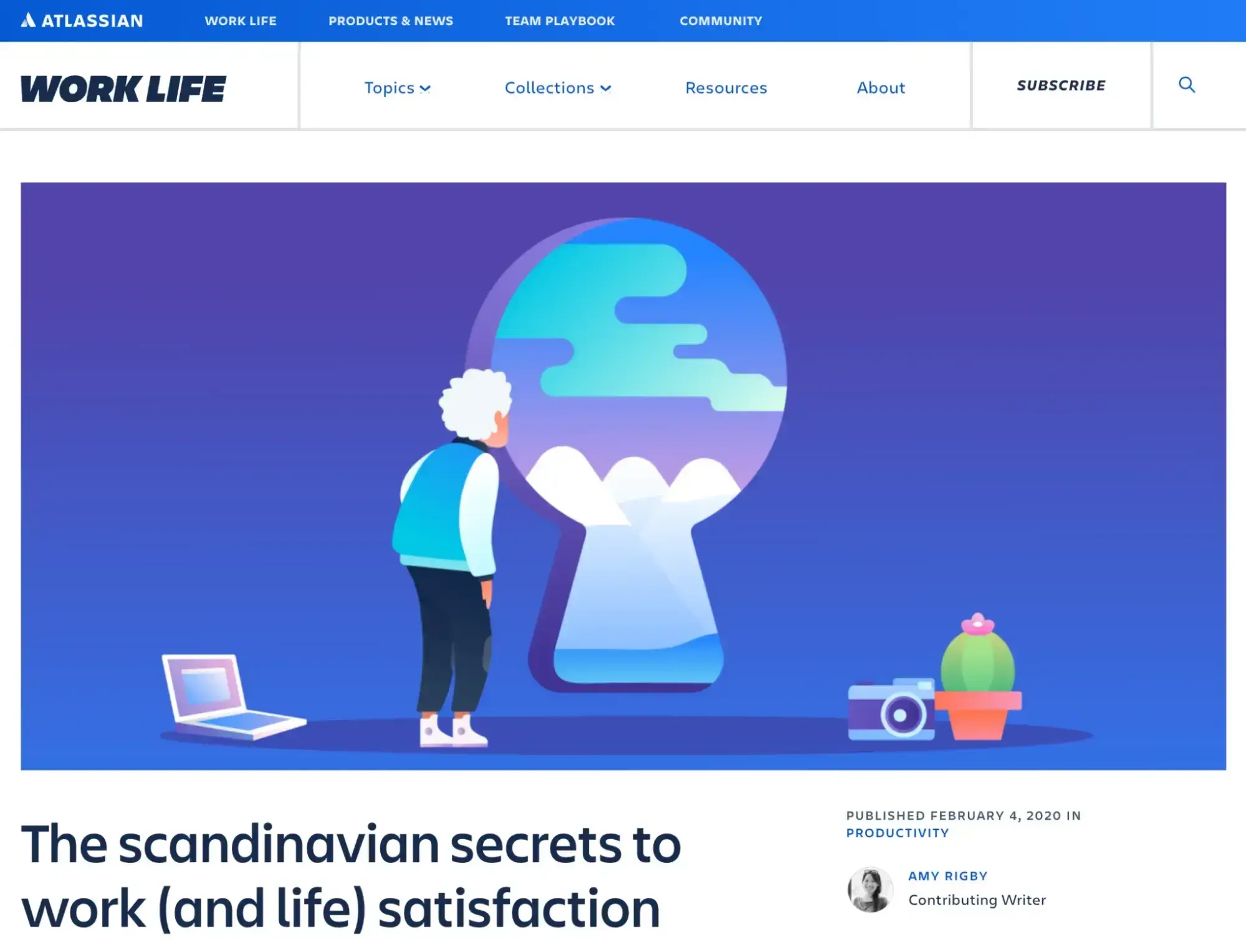
When I was a freelance contributor to the Trello blog (now the Atlassian blog), I wrote content that helped teams be more productive at work.
So when I saw that many Nordic countries were in the news lately for their happiness and excellent work-life balance, I knew I had a timely story idea on hand that added value to our readers’ lives.
I pitched a blog post to the Trello editorial team on seven ways Scandinavian countries cultivate life and work satisfaction.
How to make it your own: Stay current on the topics your target audience cares about. Consider:
- Bookmarking websites your target audience reads.
- Setting up Google alerts around specific keywords that your target audience cares about.
- Subscribing to email newsletters in your niche.
Whenever news comes up, connect it to a piece of content that your audience would enjoy and learn from. Including content about a trending topic in your niche is a great way to build credibility.
4. Dispel myths about your products.
Best for: When you have products that naturally create buzz.
Real-life example: Top 4 Myths About ProDot Shutter Button Upgrade, BUSTED from Custom SLR

Getting negative feedback about your products might make you want to hide.
Here’s why you shouldn’t: The adage of “all press is good press” rings true here because now that people are talking about your products, you hold the power of shaping the narrative through your website content.
For example, one of my former freelance clients, the photography gear brand Custom SLR, had a product that was both popular and controversial: the ProDot shutter button upgrade.
When we were coming up with ideas for blog content, we decided to tackle the online comments purporting that the ProDot was a “gimmick.”
Instead of shying away from the naysaying, we leaned into it by writing a lighthearted, humorous post that shuts down the myths. That way, anytime someone Googled a keyword related to one of those misconceptions, our blog post would be the one to show up.
Then, we promoted the piece in an email newsletter that generated lots of sales. Win-win.
How to make this your own: You probably already have your finger on the pulse of your products, but be sure to scour online reviews, forums, and customer support tickets for negative feedback on them. Address these criticisms directly in your website content.
5. Experiment with video.
Best for: Marketers looking to boost their personal brand and/or increase the time readers spend on a page.
Real-life example: I Tried 5 AI Logo Generators. Here's My Favorite from HubSpot
Marketers are always trying to get and keep visitors’ attention.
Video can help you with both. At HubSpot, we’re experimenting with embedding short-form videos into blog posts.
“People love videos, especially quick-hit videos, and it keeps people on the page a bit longer and gives them a new way to digest the information,” says Erica Santiago, the HubSpot writer leading this experiment.
How to make this your own: Ditch the idea that you need to upgrade your equipment or skill level — your smartphone and a willingness to learn are all you need!
“You have to start somewhere,” says Santiago. “Don’t be afraid to be imperfect, especially on the first try. And don’t feel like you need to invest in just wildly expensive equipment. Your phone is fine. Trust me. I did videos for YouTube for years, and I thought about getting a regular camera, but my phone was getting me through just fine.”
Start with an existing blog post and think of ways it can be enhanced with a short video. As you grow more confident, incorporate video into more blog posts you publish.
6. Repurpose existing content.
Best for: Creating new website content when you’re pressed for time.
Real-life example: 17 Famous Foods in Peru You MUST Try from The Wherever Writer
When I owned The Wherever Writer, a travel site I founded, I initially launched a Peru travel guide to diversify the business’s income streams.
What I found, however, was that the few book sales I made monthly on Amazon paled compared to the revenue generated from display ads and affiliate marketing when people visited my website.
So, I took down the book from Amazon and repurposed each chapter into a blog post instead. Those posts ranked extremely well in Google, boosting my traffic and revenue.
How to make this your own: Identify any existing content that you have that can be repurposed. This could be a podcast, video, or ebook that you turn into text for a blog post.
Even if you have a lead magnet like an ebook that’s doing well at capturing email addresses, you can still take some content from that ebook and publish it on your blog to draw additional organic search traffic.
7. Conduct original research.
Best for: When you want to focus on lead generation, backlinks, and position your brand as an authority on a specific topic.
Real-life example: 2024 B2B SaaS SEO Performance Report from Stratabeat

In early 2024, marketing agency Stratabeat knew it wanted to generate leads and help its clients, so it used the website content idea of original research to do that.
Relying on an in-house team, Stratabeat analyzed 300 B2B SaaS websites and over 15,000 data points to publish a report identifying what's effective in B2B SaaS SEO today.
“The benefits of doing this type of original research are not limited to posting on your own website,” Stratabeat CEO Tom Shapiro tells HubSpot.
“It’s deeper than that. It’s really connecting with your audience wherever they are, whether they‘re at an industry conference, whether they’re checking out a webinar, whether they are checking out your blog.”
Since releasing the report, Shapiro has been booked for speaking gigs, webinars, and podcast interviews to discuss the findings, highlighting how powerful original research can be in building brand awareness.
How to make this your own: “Understand your goals first,” Shapiro says. “You have to know what you‘re ultimately trying to do with the research. We have had companies ask us and inquire about original research without knowing what they wanted to get out of it.
And that’s a potential for wasting a lot of money, a lot of time, a lot of resources and not seeing the business value.”
Original research is great for many reasons:
- It’s uniquely yours.
- It generates leads.
- It builds backlinks.
- It helps you conduct market research.
- It creates value for your audience.
Find what matters most to you, and tailor your research around that.
8. Compare your products against competitors.
Best for: When you want more signups and conversions.
Real-life example: In-depth: PostHog vs Mixpanel from PostHog

Both PostHog and Mixpanel offer product analytics. So why would PostHog write about a competitor?
The beauty of comparison posts is that they have a high potential for conversions because they attract visitors who are in the consideration stage of the buyer’s journey.
These visitors are narrowing down their potential solutions, and you get to make that final nudge toward getting them to buy your product. Comparison posts include keywords like “alternatives” and “versus.”
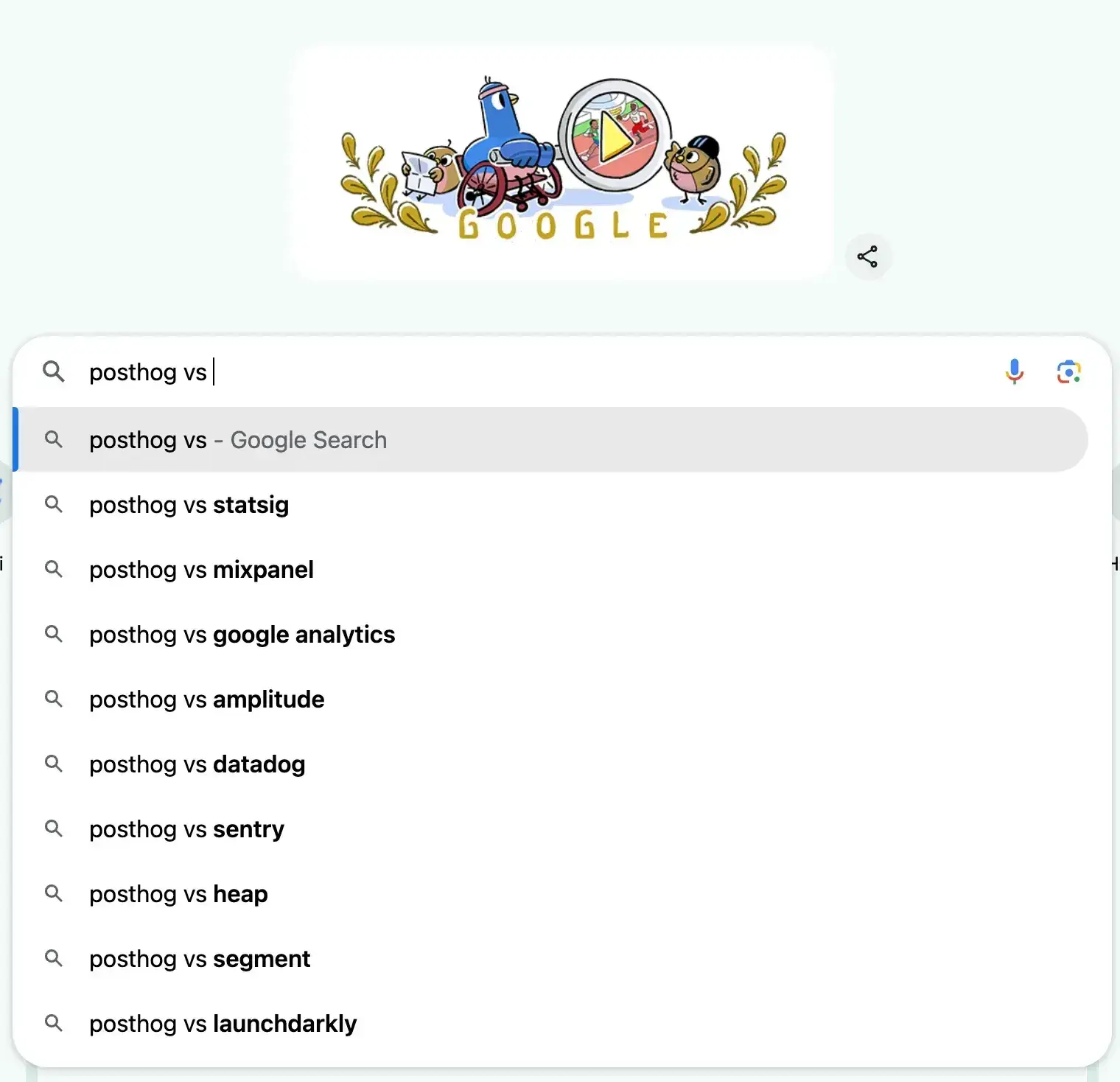
How to make it your own:
Here’s an easy place to begin with comparison posts.
- Type your business name into Google search.
- Add “vs” and see what Google suggests. This points to popular search terms your prospects are already typing in.
- Write all the suggested keywords.
- From there, write a detailed comparison of your product and your competitor’s product. Note that this is not a take-down piece on your competitor. Rather, it’s an honest take on what your product’s strengths are and who your ideal customer is.
- Be honest. Don’t make it sound like your product does everything better. Your readers will appreciate your honesty.
9. Take readers behind the scenes of your business.
Best for: Building trust with your audience.
Real-life example: Meet the Core Basics Studio from Encircled

Encircled is an ethical clothing company based in Toronto. It supports its brand values with behind-the-scenes content that shows the local manufacturers' Encircled partners with.
When I was looking at purchasing from Encircled, seeing content like this on its website helped me put a face to the brand and made me feel more comfortable supporting a company that cared so much about the environment and the people it worked with.
In fact, I ended up buying several pieces from Encircled over the years.
How to make this your own: Think of ways to showcase your brand values, help your customers understand your product better, or humanize your staff. Some ideas:
- A tour of your office.
- An introduction to your employees.
- How your products are made.
- How your team operates.
10. Refresh existing content.
Best for: When your existing website content isn’t performing as well as it used to.
Real-life example: 12 Best AI Video Generators to Use in 2024 from HubSpot
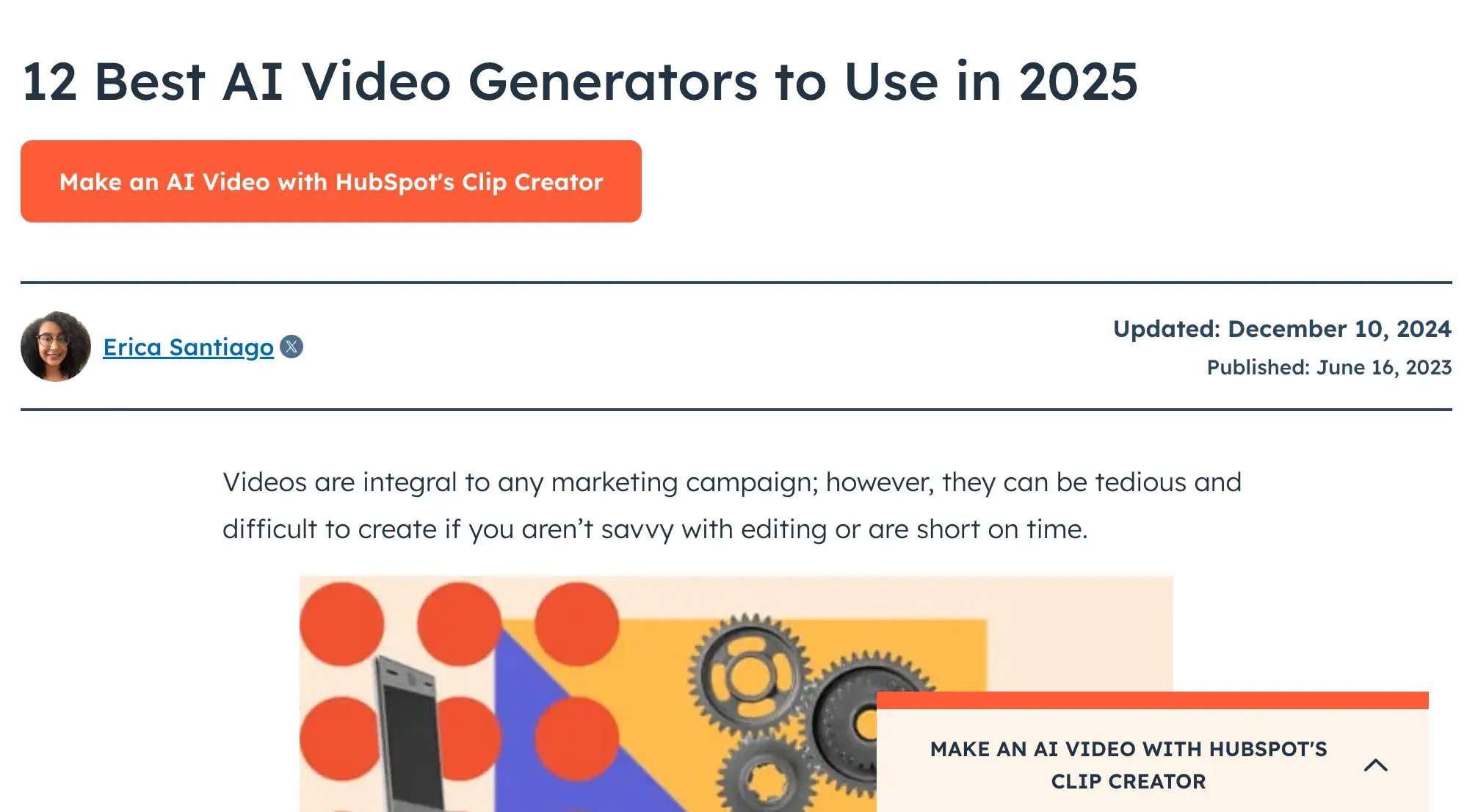
Who says website content ideas all have to revolve around creating content from scratch? Since the SERPs are notoriously volatile, your content search rankings will fluctuate, too.
If your blog posts are dropping in rankings, updating them can work wonders.
Refreshing existing content is so important that we have an entire team dedicated to it here at HubSpot: the Historical Optimization team.
I spoke with one of its members, Ivelisse Rodriguez, about a recent successful content refresh of an existing HubSpot blog post about AI video generators.
“Never, ever, ever, ignore your existing content,” urges Rodriguez. “In fact, your existing content is even more important than any new content that you can create. So I highly recommend when you‘re thinking about your content strategy or when you’re thinking about how to go about creating website content, absolutely think about your product, your readership, your target audience. And once that content is created, it's really, really important to go back and refresh that content.”
How to make this your own: Using Google Analytics or your favorite keyword research tool, look at your top-performing posts in terms of traffic over the past few months. Identify any content pieces that have fallen in search rankings.
From there, identify new keywords to target, and include them into your existing blog post as you add fresh content.
If you want to start with low-hanging fruit, find your blog posts that are marked by a year (e.g., “Top 10 Design Apps of 2022” and update the title and list for the current year.
I guarantee some things you’ve linked to in the old list are no longer relevant, have increased in price, or have some new feature that your readers will want to know about.
11. Invite guest authors to publish on your website.
Best for: Including third-party expertise in your website.
Real-life example: DZone’s top-performing post of all time: “Top 20 Git Commands with Examples” by Sahiti Kappagantula
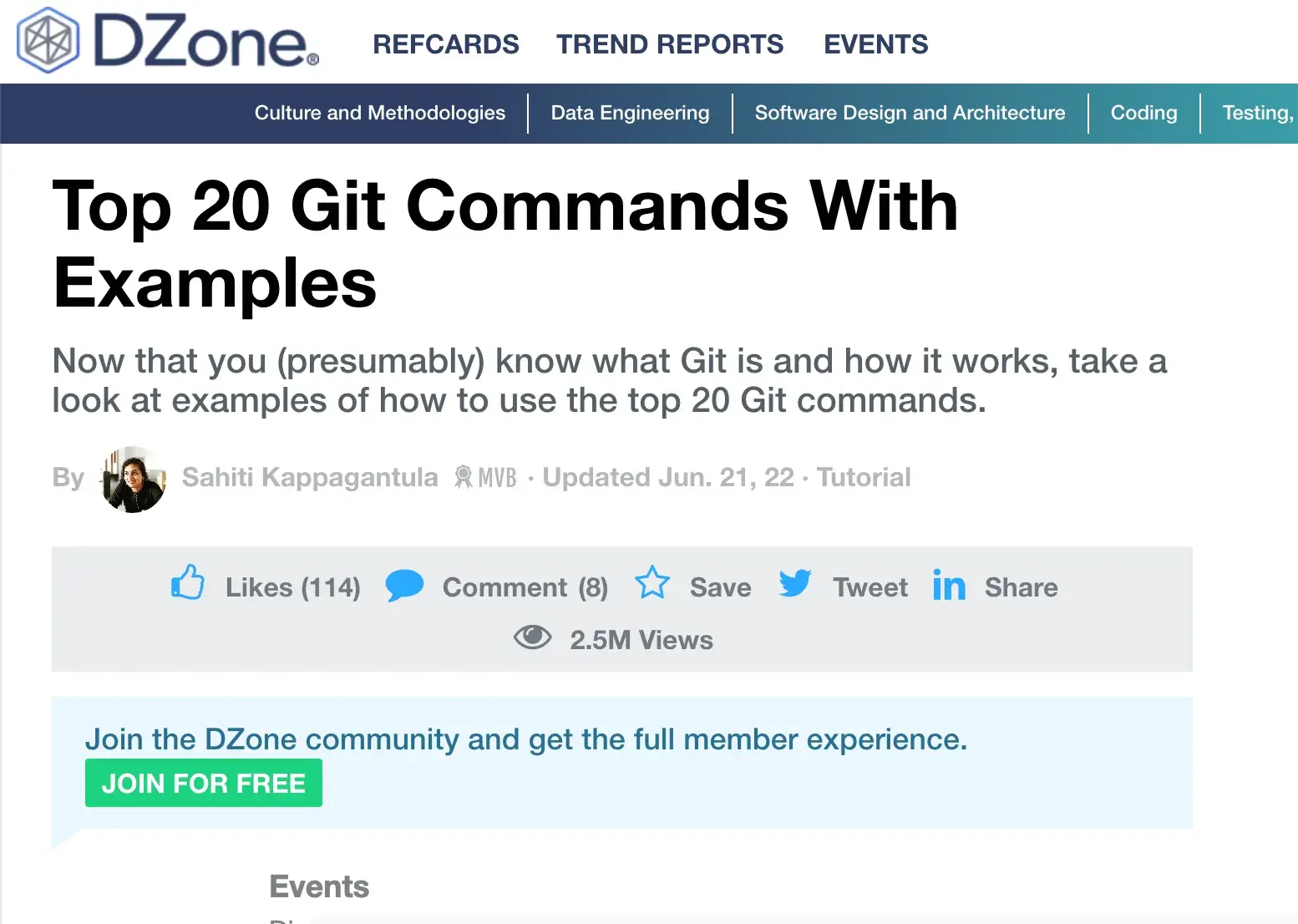
If you lack the resources to create expert-level content, you can invite industry professionals to publish guest posts on your site. DZone is one brand that has achieved success with this idea. According to Ahrefs, one of DZone’s top-performing posts (Top 20 Git Commands with Examples) is a guest article by Sahiti Kappagantula, a product manager at Microsoft.
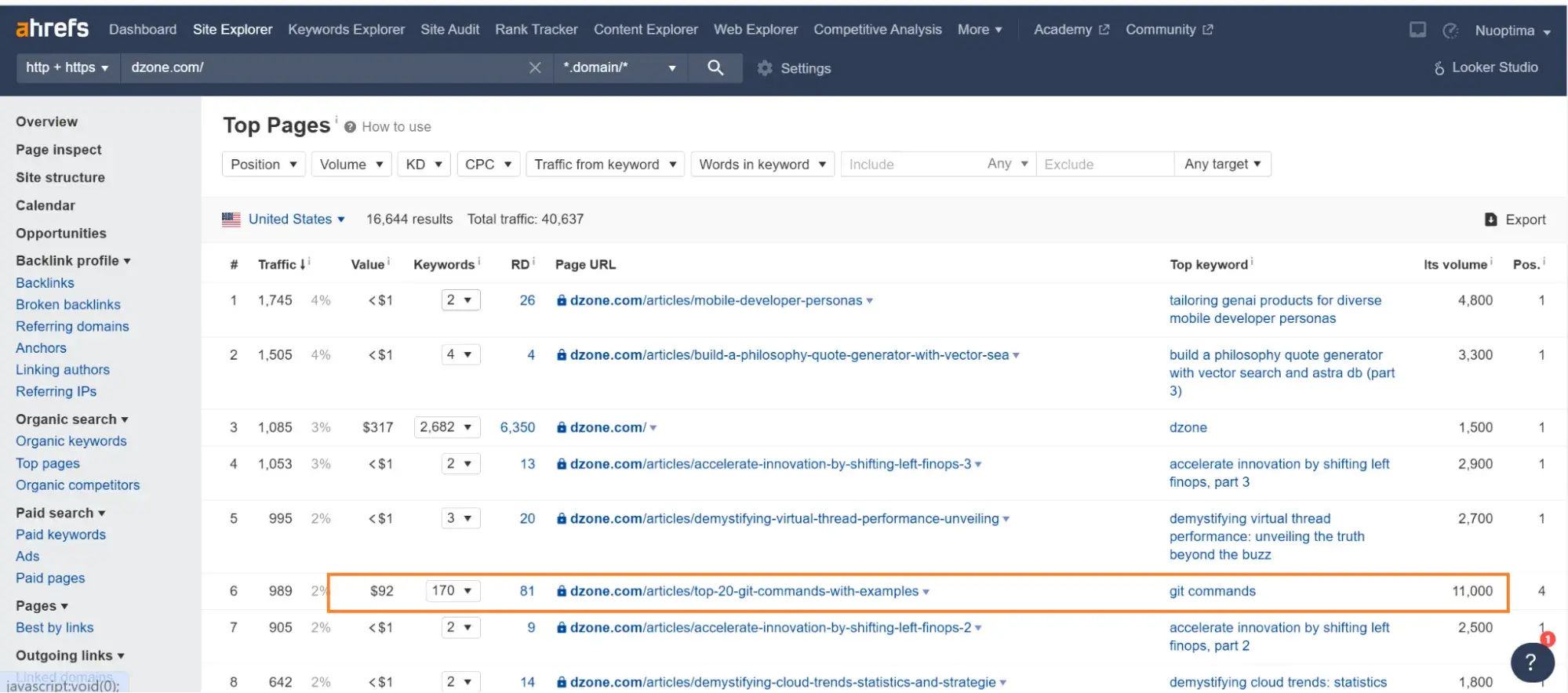
So, how did someone who never worked for DZone land and hold the top spot for three years?
Here’s a quick backstory. DZone launched in 1997 as an online hub for Java developers and gradually shifted into a developer-focused media company. Their content strategy focuses primarily on expert-written guest posts.
Marcy Tillman, DZone's editorial lead, explained the reasoning behind this move:
“Developers prefer learning over marketing. They're not impressed with standard claims that a product happens to be the best — they want to know the nitty-gritty details on how you solved problem X or implemented solution Y.”
How to make this your own: Start by getting a clear picture of what your audience needs. Set up a simple editorial guideline so contributors know what kind of content to pitch. Build a team to review submissions. And finally, only hit publish on articles that tick all the boxes in your guidelines.
12. Publish case studies (lots of them).
Best for: Focusing on various ideal customer profiles.
Real-life example: HubSpot’s multiple case studies for different customers
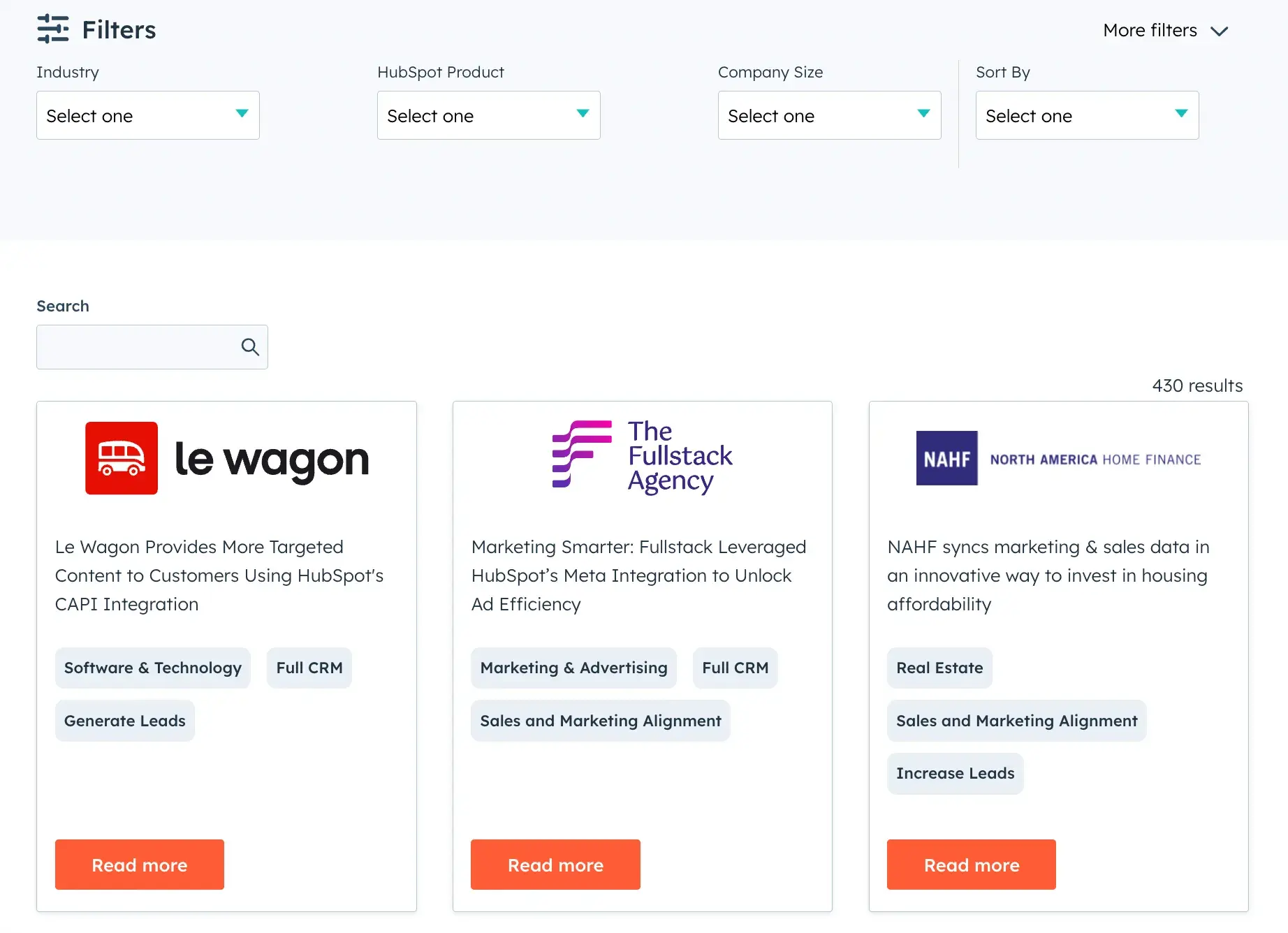
According to HubSpot’s State of Marketing report, case studies are among the top five types of content marketers rely on. Case studies build trust, provide social proof, and help you stand out in a crowded market.
Here at HubSpot, we’ve published 430 case studies and this number will rise. One element of the case study hub I like is the filters. As a user, I can check for an industry similar to mine and sort by company size and product.
How to make it your own:
- Start by choosing a customer success story you want to highlight — preferably one with a clear problem and impressive results.
- Talk to the people involved (your client, your team) to gather all the juicy details about what went wrong, what went right, what you did, and how it turned out.
- Write the case study like you’re telling a story, making sure to show the problem, solution, and results in a way that’s easy to follow.
- Add proof, like stats or quotes, to make it convincing — nobody trusts vague claims.
- Finally, keep it short and interesting.
13. Create content that challenges norms in your industry.
Best for: Positioning your brand as thought leader and sparking engagement.
Real-life example: Novos’ blog post: “Stop Building an Instagram Brand”
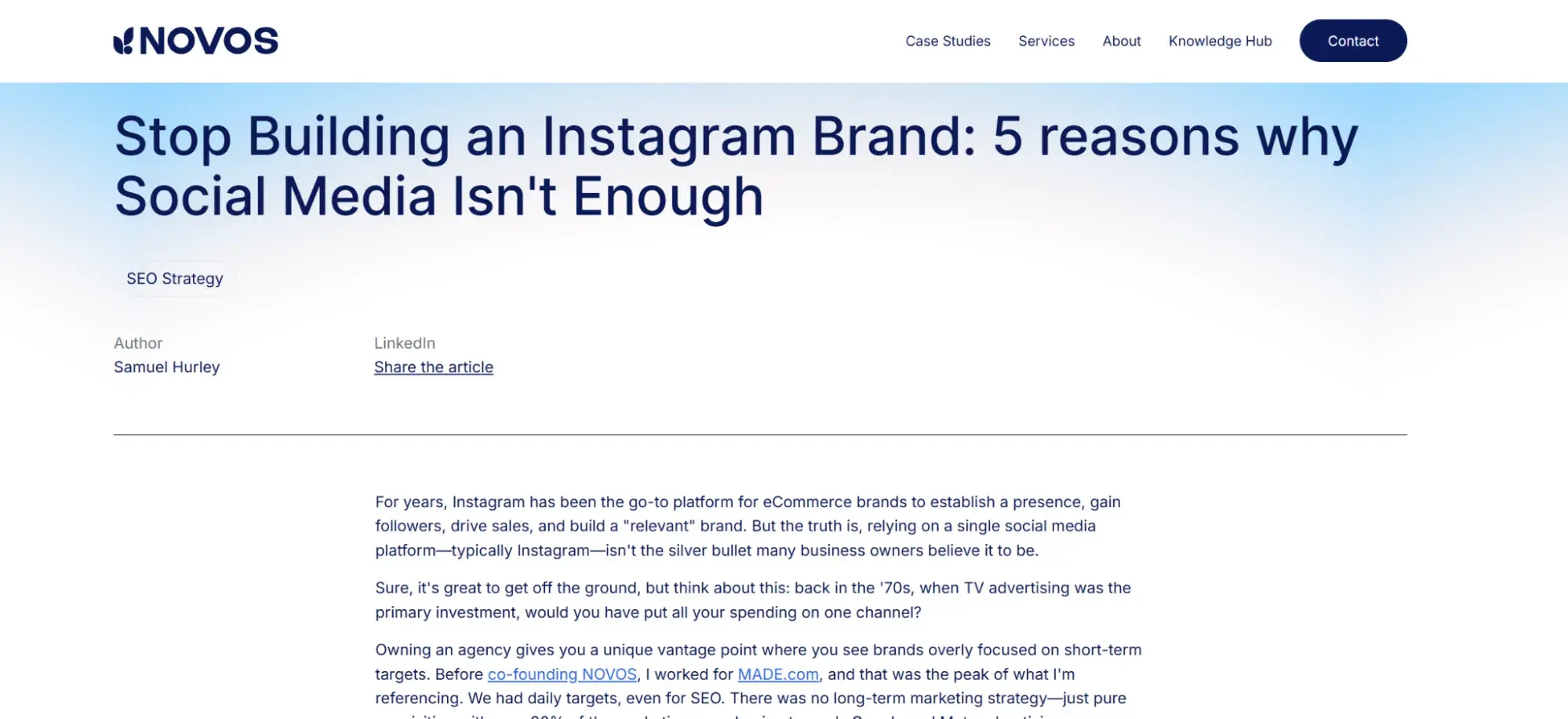
For years, marketers have emphasized the benefits of building brands on Instagram, Facebook, and other social media platforms. In fact, if you search for “why you should build your brand on Instagram,” you'll get over 600 million Google results.
So, imagine my surprise when I stumbled on a blog titled “Stop Building an Instagram Brand.” I clicked out of curiosity, read it, and I found their points relatable. If I were a potential client, I'd want to contact their sales team or check their social media accounts to get a better sense of their brand.
What really grabbed my attention, though, was their title — it wasn't just catchy; it boldly challenged the industry norm. Such content can spark fresh ways of thinking that could lead to new solutions, better products, and improved services. Topics like this ignite healthy debates that translate to higher engagement and improved brand visibility.
But there’s more. Such content resonates with audiences who feel frustrated by the status quo. Take “stop building an Instagram brand” — this could hit home with small business owners facing endless bans or account issues on Instagram.
How to make it your own: Ask what if questions.
- What if everything we know about X is wrong?
- What if traditional methods no longer work?
- What if we completely changed how we approach Y?
- What if X practices have become outdated or irrelevant?
These questions can lead to surprising insights and unique content ideas.
You can also talk to contrarians and influencers with a knack for thinking differently. Note that challenging norms is about offering new perspectives, not just for the sake of controversy. Your content should offer alternative approaches, solutions, or insights and leave your audience with takeaways that help them think differently or solve problems.
14. Answer FAQs with dedicated pages or posts.
Best for: Providing detailed answers to customer queries.
Real-life example: WhatsApp’s FAQ section
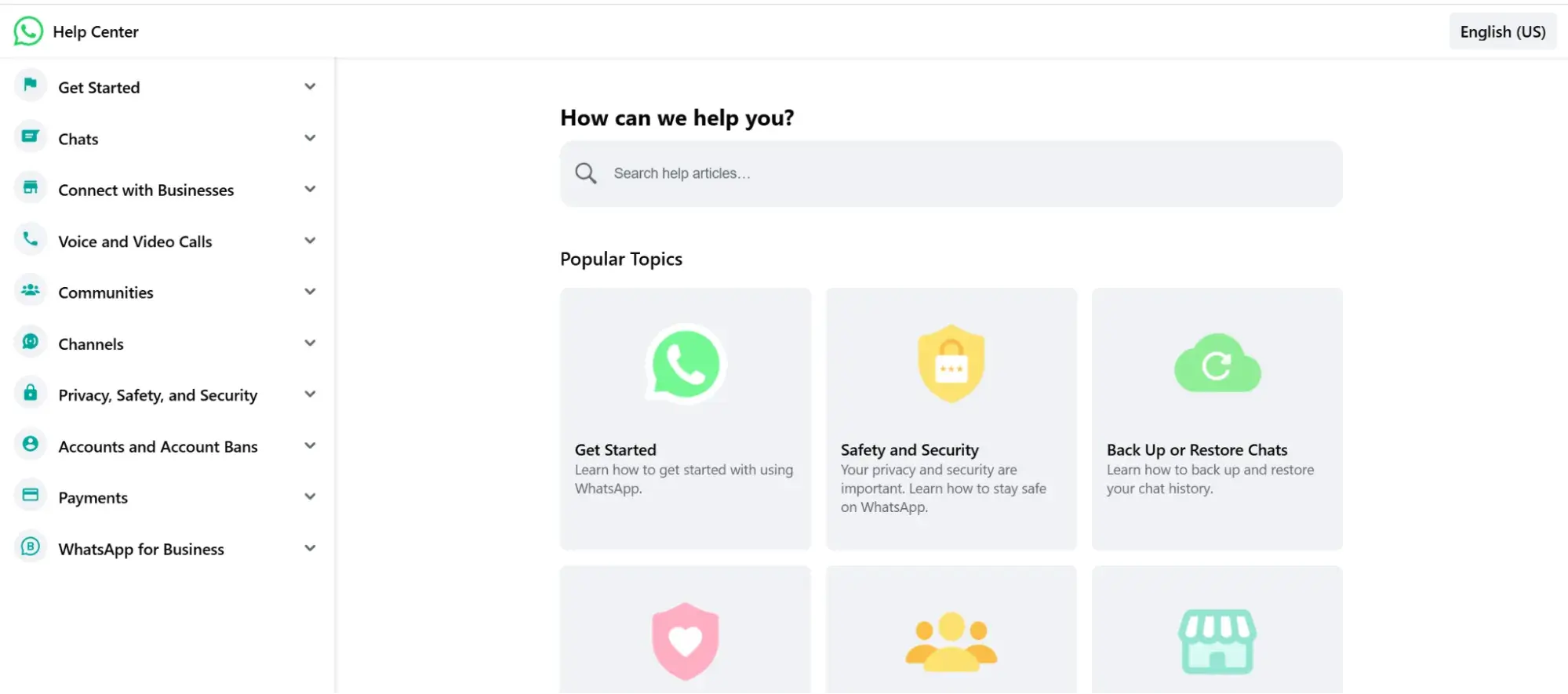
Brands often use FAQs to answer common queries.
But what if your FAQ page could do more than answer questions? What if it could become a goldmine of content ideas? Instead of sticking to answers that may be shallow, why not turn those FAQs into blog posts? Here’s how WhatsApp does it.
WhatsApp treats each question on its FAQ page like a mini blog post of around 500 words. They’re structured with an intro, body, conclusion, a conversational tone, images, and even internal links to other relevant FAQs.
How to make it your own:
- Create a single FAQ page or list the questions at the bottom of your homepage.
- Next, create sub-pages and interlink them to each FAQ. In each sub-page, answer each FAQ in blog format.
- Structure your FAQ section to enable your readers to move from general definitions to practical how-to guides that’ll help them use your products/services.
15. Flesh out your social media content into blog posts.
Best for: Repurposing social media content for blog audiences.
Real-life example: Scale by Tech transcribed and edited Alex Hormozi's YouTube videos into blog posts.

Turning your social media content into blog posts is pretty easy. You take a post, copy and paste or transcribe it, and expand and edit it to fit your blog structure.
Take Alex Hormozi, for example. His brand became popular on YouTube before expanding to other platforms. Since October 2020, Scale by Tech, an AI content agency, has helped him automatically transcribe his YouTube videos into blog posts.
This move is great, especially for those who prefer scanning text over watching an hour-long video. They even embedded the YouTube videos directly into the blog posts, so readers like me could skim the text, and if I want, spend 50+ minutes watching the full video and boosting my time spent on the page.
But it’s not just video that can be turned into blog posts — text-based social media posts can work, too.
How to make it your own:
- Pick a social media post with good engagement. (High engagement means it’s already resonating with your audience, so it’s a solid choice for a blog.)
- Copy the post to your editor and remove any formatting that’s unideal for your blog.
- Then, expand on the content with by adding examples, images, points, links, etc.
- Once you're done writing, proofread, edit, and publish.
This method ensures your content will hit home with your audience since it’s based on topics they already care about.
But here’s the catch: if you don’t add new insights, the content will feel repetitive and won’t deliver much value.
16. Create a comprehensive glossary.
Best for: Simplifying complex terms.
Real-life example: Clay’s glossary page
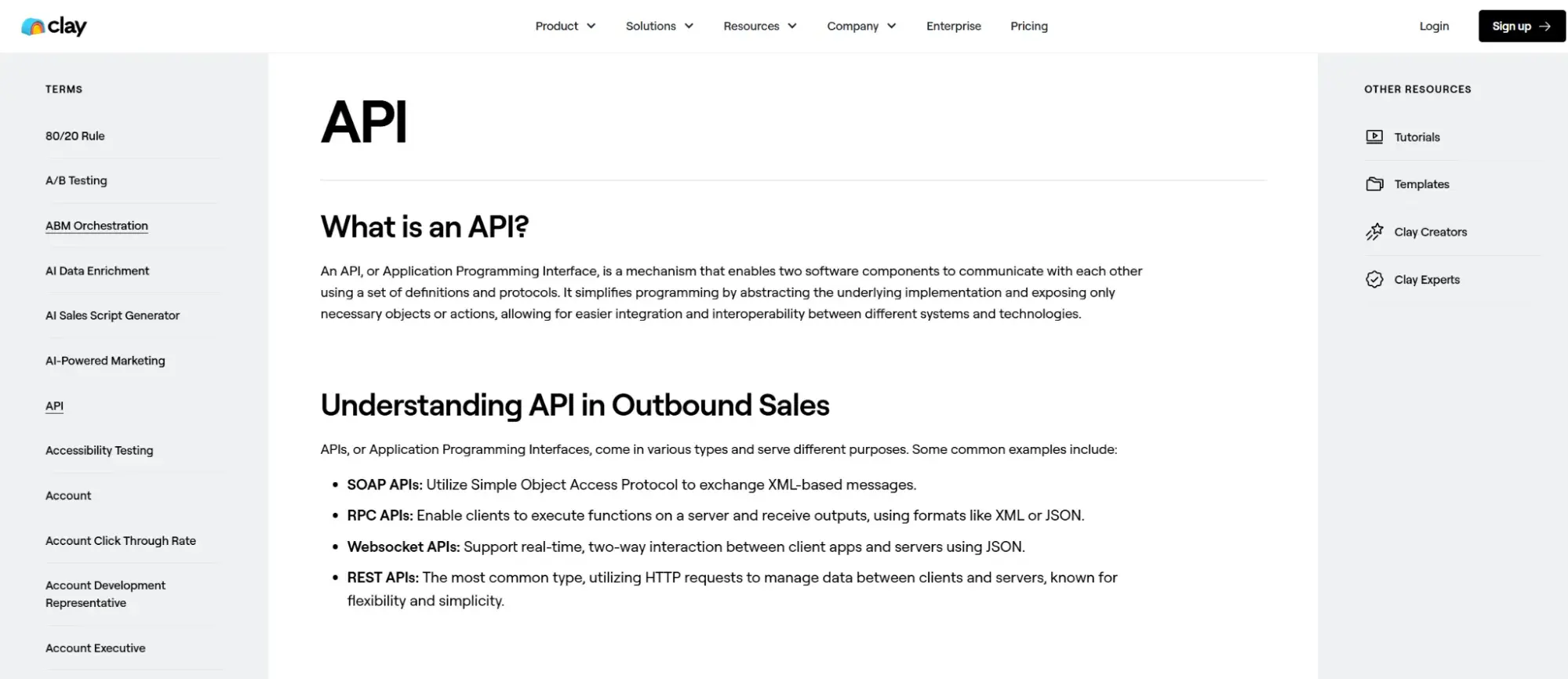
A glossary is a list of terms related to your products or services designed to help visitors understand industry-specific lingo. Most glossaries are like FAQ pages — one page, short, concise definitions for each term.
But what if, instead of quick definitions, why turn each term into an article?
Enter Clay. Clay created a single glossary page but went further by linking each term to its own detailed blog post. I clicked on the term “API,” and the link opened a blog-like page explaining everything. It covered the meaning, types, benefits, best practices, and how API fits into Clay's work as a creative marketing agency.
It’s a clever way to both educate your audience and improve your SEO.
How to make this your own:
- You probably know several terms specific to your industry. But to get a full list, I recommend you use AI tools like ChatGPT to find more.
- Next, explain each term as an article and include links to related terms to help readers learn more.
- Make each definition feel less like a textbook and more like an engaging conversation.
17. Offer predictions into the future of your industry.
Best for: Brands looking to establish themselves as thought leaders.
Real-life example: Keyfactor’s 2025 Trends and Prediction articles
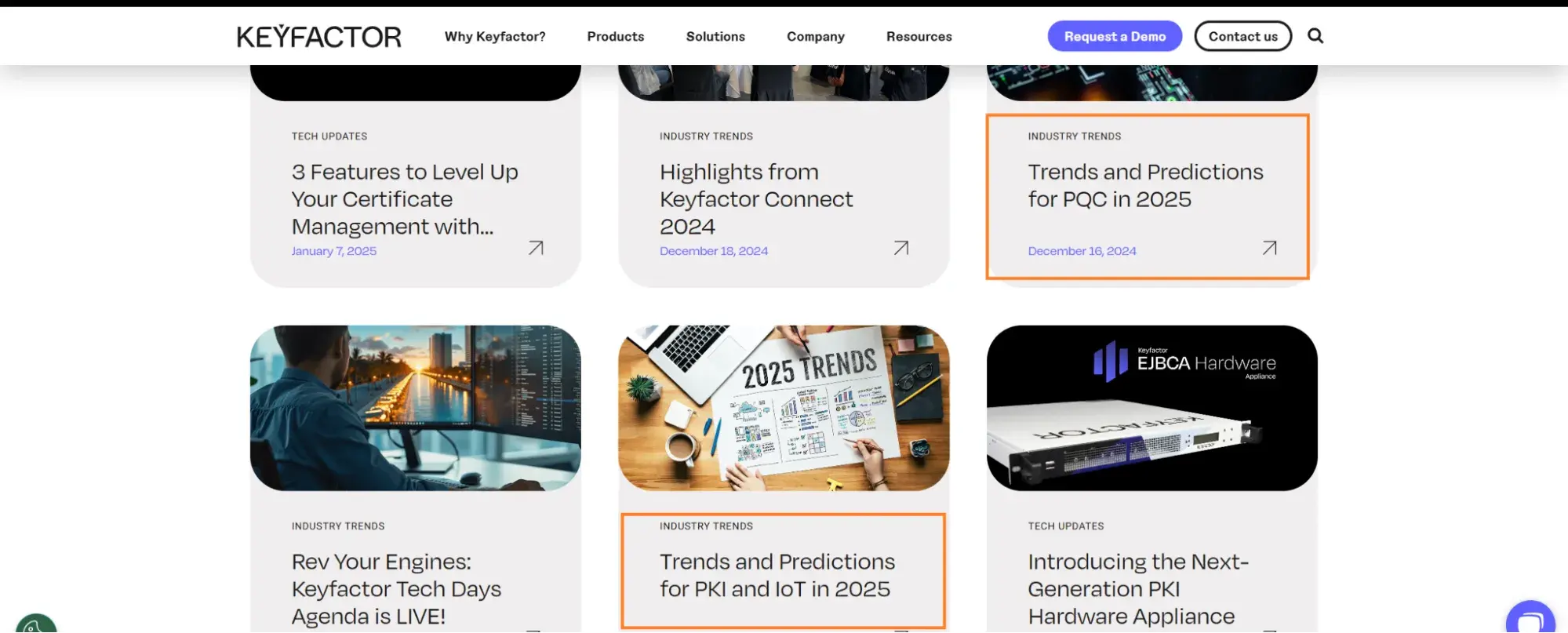
People get curious about what's coming next, especially at the start and end of the year. So, by sharing timely, well-informed predictions, you can position yourself as a thought leader and build credibility.
How? By publishing your thoughts. Your published articles also serve as a measure to track the accuracy of your predictions as the year unfolds.
Take Keyfactor, for example. They began publishing predictions and trend content. According to Kala Cole, Keyfactor's senior development manager, they started writing these articles in 2023 as part of their marketing plan to become an industry leader.
How to make it your own: Kala mentioned that what makes prediction articles stand out from regular articles is expert insights. So if you’re not an expert, creating such articles will require you to interview top execs — think CSOs, CTOs, and others who understand your industry. Afterwards, organize the interview notes, and turn the insights into a polished article.
Here's my extra tip: Don’t just predict trends — show your audience how those trends will affect them. Give actionable insights they can use, just like Keyfactor did in their “PKI and IoT Predictions 2025” article.
18. Build your business in public.
Best for: Companies aiming to foster authenticity with their audience.
Real-life example: Groove’s Startup Journey section
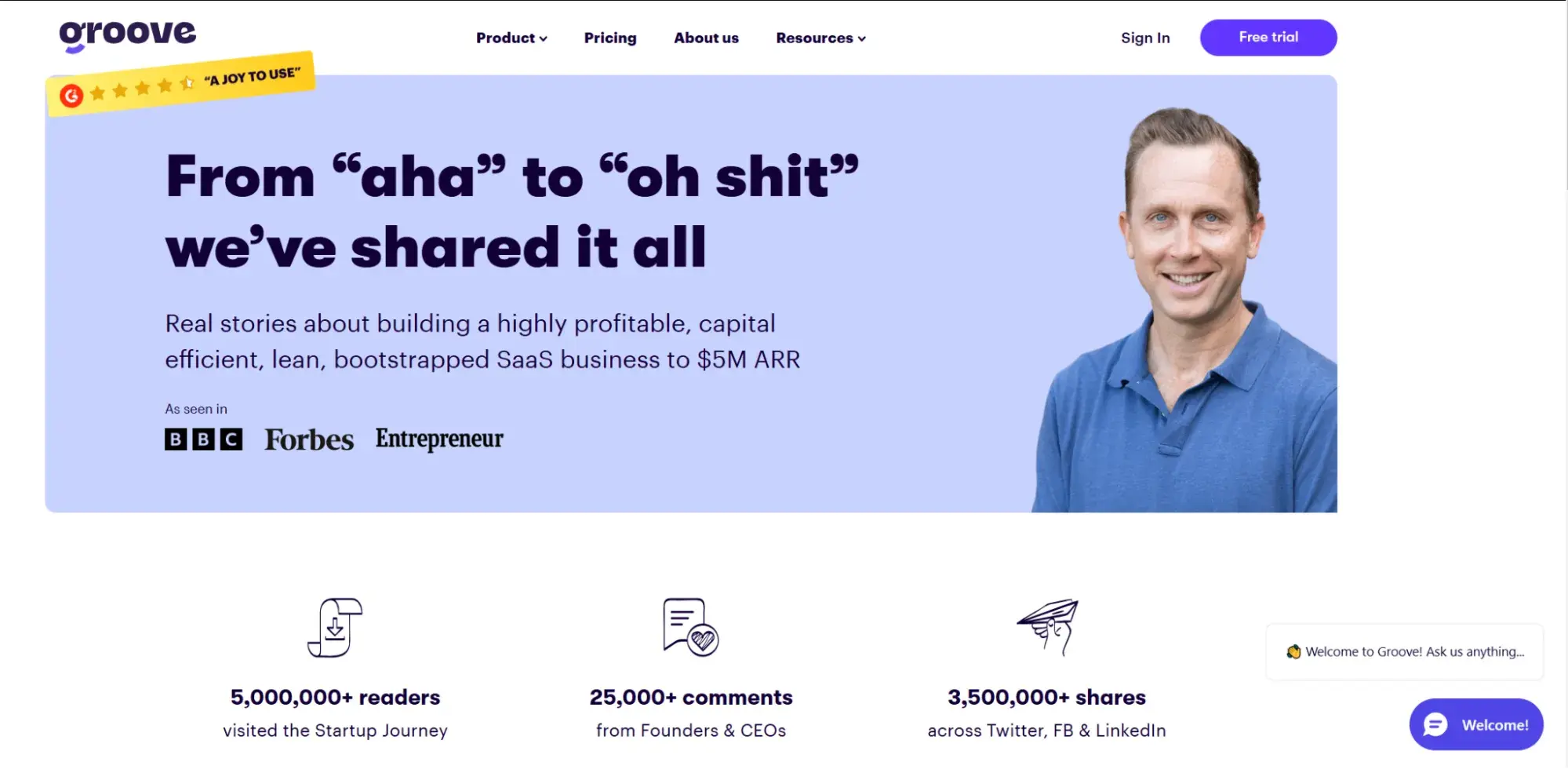
People crave authenticity, so behind-the-scenes content is a goldmine. Building a business in public means sharing updates, milestones, and challenges. It helps boost trust, creates a sense of community, and sparks marketing buzz.
This is an idea Groove has been using to fill its Startup Journey Blog section with interesting posts.
When I first found Groove, I couldn’t stop reading. Why? Its blog wasn’t just about selling a product — it was about telling their story. Stories written by Groove’s founder, Alex Turnbull.
Turnbull launched Groove in 2012 as a shared inbox solution for small businesses. To share the company’s growth journey, he published posts like:
- How We Got 1,000+ Subscribers From a Single Blog Post in 24 Hours
- Why I Turned Down $5 Million in VC Funding
- What I Did When I Couldn’t Find a Technical Co-Founder
One reason I like this blog section is that it doesn’t try hard to sell to the reader. And with over 250,000 subscribers, it’s a treasure trove of small business insights that Groove’s audience can use in their businesses. That’s a win-win.
How to make it your own:
- Every business has a unique story. Lean into that and share it. Maybe it’s the challenges you faced launching your product or the pivotal moments that shaped your team.
- Write them like a conversation, not a press release. Speak from someone’s point of view — the founder, a team member, or anyone with a story to tell.
- Use personal pronouns to make it relatable. And don’t just tell the story; share the lessons your audience will care about.
19. Publish your income report.
Best for: Entrepreneurs aiming to provide insights into their business performance and establish trust.
Real-life example: Defactor’s annual income reports for four years

I signed up for Lex Roman’s Journalists Pay Themselves newsletter back in October 2024. In her welcome note, she casually mentioned what journalists make from newsletters. Since I’ve always wanted to start my newsletter, that sentence caught my attention. When I clicked the link, I found another one of her newsletters where she shared how much top newsletters, like Defector, earned, all backed up by figures from their annual reports.
Turns out annual reports is a thing, and it's pretty popular. For small businesses, these reports double as marketing tools. If you’re in blogging or content creation, your annual report can give investors and advertisers a behind-the-scenes peek at how well you’re doing.
But it‘s not just about bragging rights. It gives both the business and its customers a bird’s-eye view of what worked and what didn't and helps in rethinking strategies for the future.
How to make it your own:
- Document your revenue and expenses throughout the year.
- Focus on key financial metrics to build credibility, but also skip financial jargon your audience may not understand.
- Since the goal is to keep it clear, readable, and engaging, use Defector’s report as a template. Start with a clear intro, clearly present your financial data and add context to explain what the numbers mean.
20. Create post-event content.
Best for: Brands who want to extend the buzz from an event and maintain engagement.
Real-life example: Jellyfish’s Unleashing Innovation: Insights from Our Hackathon blog post
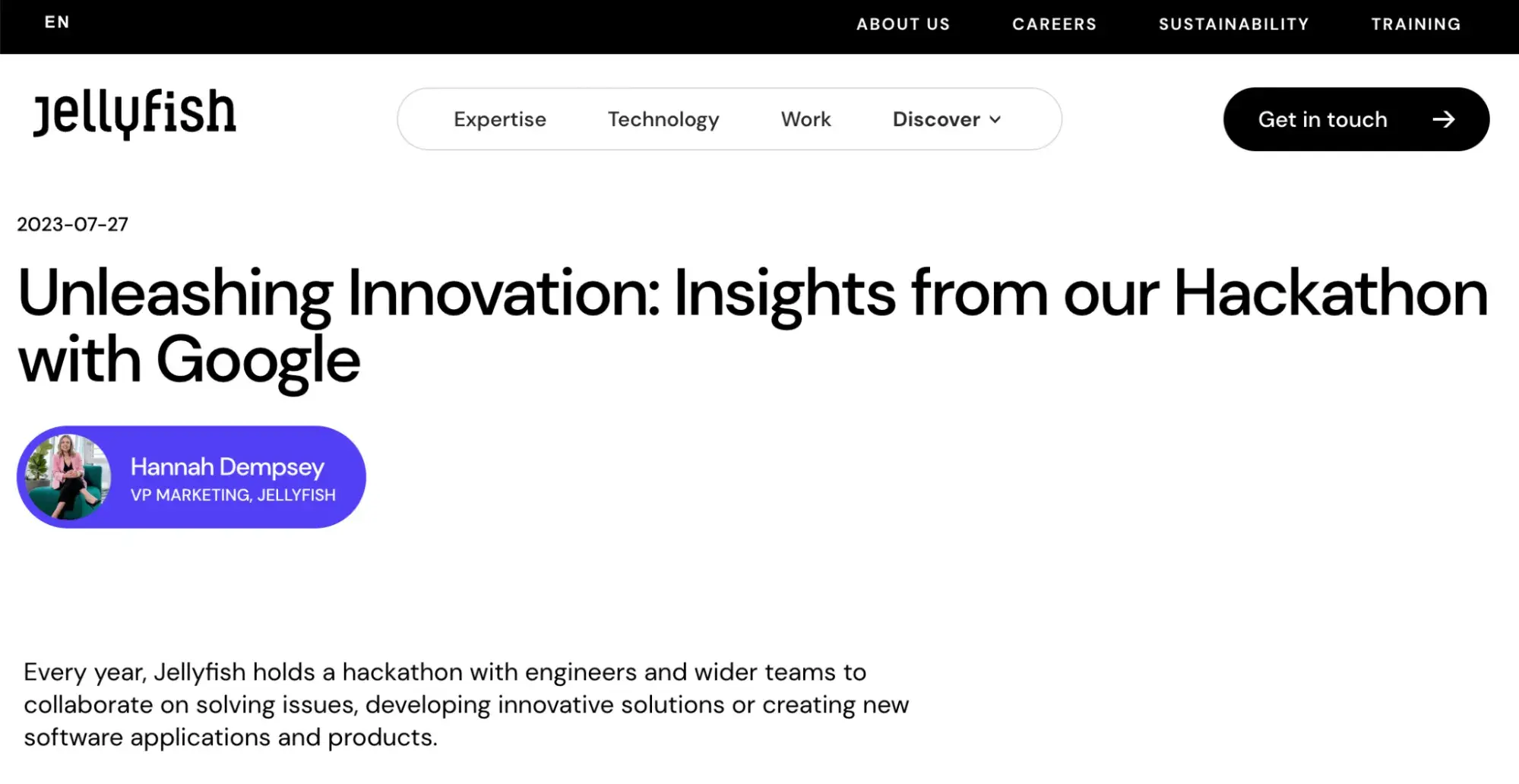
The buzz around an event fades quickly once it's over. Not necessarily a bad thing, but what if you could keep that energy a little longer while doubling as a unique website topic idea?
Jellyfish, a creative media company, collaborated with Google to host a hackathon in Paris. They published post-event content where they summarized the activities during the events and described highlights.
How to make it your own:
- Whether you hosted the event or just attended, you can turn the insights, recaps, and recordings (make sure you have permission to use this) into a blog series. This series could open the door to new connections, especially if it was a big event.
- Start by recapping the event: what it was about, key moments, and why it mattered.
- Share insights, quotes, or lessons from speakers or attendees — these add value and keep readers engaged.
- Include visuals like photos, videos, or recordings (with permission) to bring the event to life.
- End with a personal touch, like your takeaways, and encourage readers to join your next event or share their thoughts.
Website Content Ideas: A Recap
From my interviews with the experts and from reflecting on my own experience as a content marketer, three major themes stood out regarding website content ideas:
1. It’s all about understanding your audience first. Every single one of the successful website content ideas shared in this article began with the creator’s deep understanding of their audience and their audience’s problem.
2. Keyword research is crucial — but it isn’t the only thing to consider. For content marketers, it often feels like it’s all about the keywords, but don’t let SEO alone drive your website content.
I loved what Gabe Prusak from Tilt had to say about this: “We‘re not anti-analytics. All of our creative briefs that we do for every campaign include keywords — it’s just not the driver.
We kind of work backwards and say, ‘Here are the themes that are important to our customers. How do the keywords maybe fit in?’”
3. Your website content can go way beyond the website. Tom Shapiro’s B2B SaaS report started as a downloadable PDF on his site, but it became the topic of podcasts and webinars too.
Don’t pigeonhole yourself into thinking your website content can only live on your blog. It can and should go way beyond!
Editor's note: This post was originally published in September 2024 and has been updated for comprehensiveness.
Content Creation
.png?width=112&height=112&name=Image%20Hackathon%20%E2%80%93%20Vertical%20(50).png)

.png)